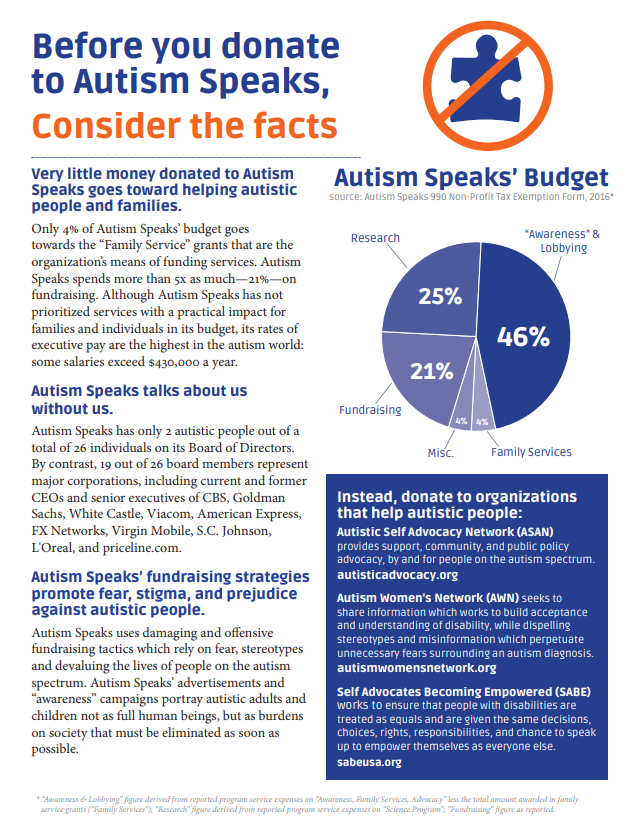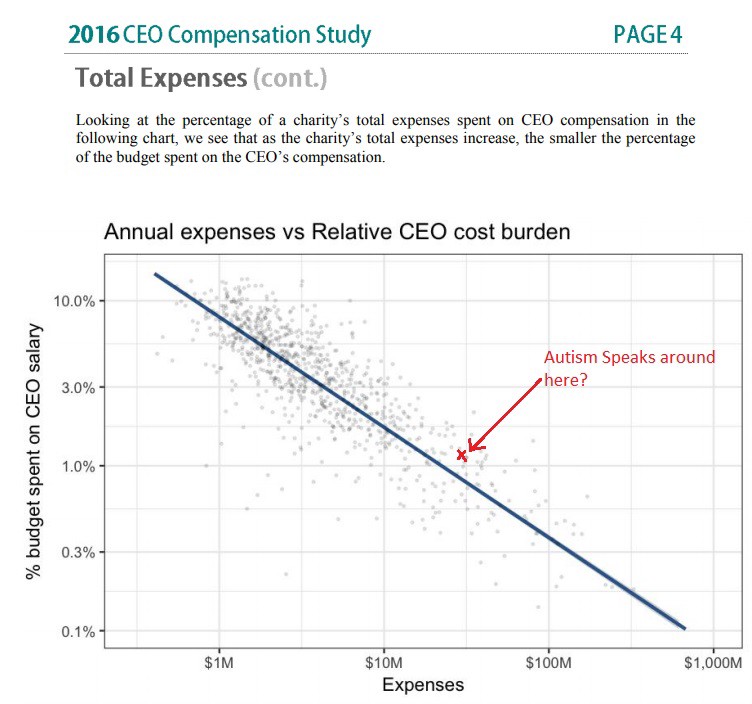More strange facts to consider from ASAN's flyer

Besides the strange math, let us consider the other claims laid out in this flyer.
Very little money donated to Autism Speaks goes towards helping autistic people and families.
Only 4% of Autism Speaks’s budget goes towards the “Family Service” grants that are the organization’s means of funding services.
On the surface the sentiment is correct. Very little of the budget (5.34%, not the 4% stated) goes towards grants in Autism Speaks’s Awareness, Family Services, Advocacy program. It seems that their definition of “helping autistic people and families” only includes money that is directly going to other organisations or people.
Let’s go with that for the moment and take a look at ASAN’s 2016 form 990. They gave $39,090 in grants while having a total budget of $738,688 that year. Going by their own definition, only 5.29% of their budget went towards “helping autistic people and families”. This amount is smaller than Autism Speaks’s 5.34%. Talk about pot calling the kettle black!
Call me autistic but I take the phrase “helping autistic people and families” very literally. First of all, with any grant program there needs to be people who review grant applications and people who audit the organisations whose applications are approved, just to make sure that the grant money is used to actually help autistic people and families. These people would need IT equipment to do their job. Some of these people might need to travel to other cities in order to do their work and I wouldn’t expect them to walk there. I wouldn’t expect them to sleep on the streets. And I would expect them to be paid a decent salary. All these expenses that wouldn’t have been filed under grants are “helping autistic people and families” too.
According to Autism Speak’s 2016 form 990, they also:
LAUNCHED A THREE-YEAR INITIATIVE CALLED ADVICE: THE AUTISM & DISABILITY VISUAL INTEGRATION COMPANY EXPERIENCE. IT CONNECTS NATIONAL COMPANIES TO LOCAL DISABILITY RESOURCES, WHICH IN TURN CONNECT THOSE FIRMS TO QUALIFIED JOB CANDIDATES ON THE SPECTRUM.
And also:
ON THE FEDERAL LEVEL, AUTISM SPEAKS WORKED CLOSELY WITH GRASSROOTS ADVOCATES AND CHAMPIONS IN CONGRESS TO INCLUDE PROVISIONS IN THE LANDMARK 21ST CENTURY CURES ACT THAT WOULD POTENTIALLY ACCELERATE BIOMEDICAL INNOVATIONS FOR PEOPLE WITH AUTISM AND IMPROVE PATIENT INPUT IN THE DRUG APPROVAL PROCESS.
The expenses and salaries of these advocates, isn’t it “helping autistic people and families”?
And what about research expenses? In 2016, Autism Speaks funded research into Central Audio Processing Disorder and Oxytocin as a treatment option among other things. Isn’t this “helping autistic people and families” as well?
If you take things as literally as me then you will see that Autism Speaks spent $34,917,073 out of $46,739,673 “helping autistic people and families”, which was 74.7% of their cash budget in 2016.
Now, if you do the same with ASAN’s 2016 form 990, they spent $656,071 out of $738,688 on program expenses, some 88.8% of their budget. This might look good at first glance but if you take a closer look, a total of $135,235 was paid to the two directors in 2016 but the reported compensation of directors reported under management and general expenses was only $10,157. The trend continues in other years. In 2015, the director was paid $85,050 while compensation to directors under management expenses was only $3,540. In 2014, $80,000 was paid to the director while compensation to directors under management expenses was only $8,359.
According to Linkedin, ASAN has 21 employees while Autism Speaks has 569. As a smaller and leaner organisation, it is definitely possible that ASAN doesn’t need their director/s to spend as much time on management compared to a huge organisation like Autism Speaks. But I don’t know what the job responsibilities of an executive director are in ASAN. I can only calculate the worst case scenario of all compensation to the executive director/s being misreported under program expenses and present a range of values. With that in mind: In 2016, ASAN spent between 70.5% - 88.8% of their budget on program expenses. In the worst case scenario this is lower than Autism Speaks. In the best case scenario, this is impressive but understandable given the lower management overhead of a smaller organisation.
Which brings us to the next point:
its rates of executive pay are the highest in the autism world: some salaries exceed $430,000 a year.
On the surface this is literally true. Angela Geiger, the president of Autism Speaks was paid $439,025 in 2016. But this fails to take into account that Autism Speaks is also the largest autism charity in the world and that CEO pay goes hand in hand with the size of the charity. According to Charity Navigator’s CEO study

As you can see from the graph above, Autism Speaks’s CEO pay is par for the course.
The second point the flyer makes is that:
Autism Speaks talks about us without us.
However the next line is:
Autism Speaks has only 2 autistic people out of a total of 26 individuals on its Board of Directors.
Call me autistic again but doesn’t “without” literally mean none or lacking? 2 is not none. 2 out of 26 is 1:13 which, compared to CDC’s 1:59, is 4.5 times more neurodiverse than the general population. How much neurodiversity does it take for it to be enough? 1:5? 1:2? 1:1? And when it is 1:1, isn’t that not neurodiverse anymore? Neurodiversity is the diversity of human brains and minds, the infinite variation in neurocognitive functioning within our species. To me, that sounds like it includes neurotypical people as well.
The final point the flyer makes is that:
Autism Speaks’ fundraising strategies promote fear, stigma and prejudice against autistic people.
Call me autistic, the third time’s the charm, but if they had said that Autism Speaks promoted fear, stigma and prejudice, they would have had a point. There are some old PSAs that Autism Speaks have put out that could have been described this way. However, this flyer was published in March 2018 and here is what Autism Speaks was publishing for Autism Awareness Month 2018.
Exactly how are these videos promoting fear, stigma and prejudice against autistic people?
The flyer also faults Autism Speaks for spending too much on fundraising. It is important to understand that fundraising expenses aren’t necessarily a bad thing. In 2016, Autism Speaks spent $9,981,115 to raise $47,544,741, which means that they spent about $0.21 to raise $1.00. If they had spent less on fundraising, they probably would have had less to spend on their program expenses.
In 2016, ASAN spent $15,036 to raise $374,845, which is a fundraising efficiency of $0.04. That’s impressive! If they had spent more on fundraising, who knows how much more money they could have had to spend on their program expenses? But if their fundraising strategy consists of publishing this kind of crap so that they can undermine the efforts of another charity organisation, shame on them!